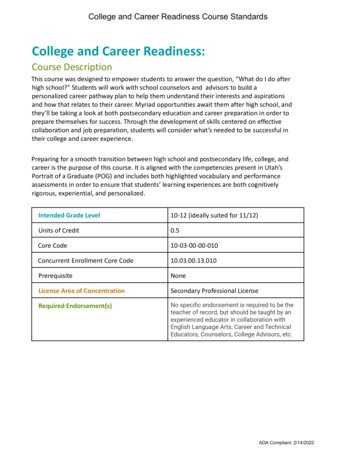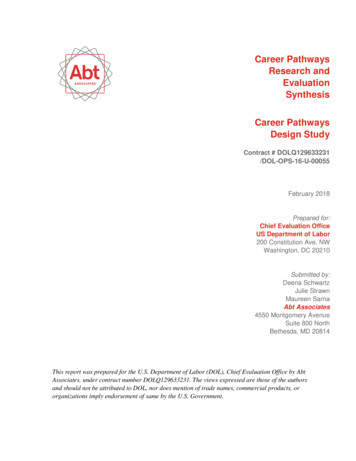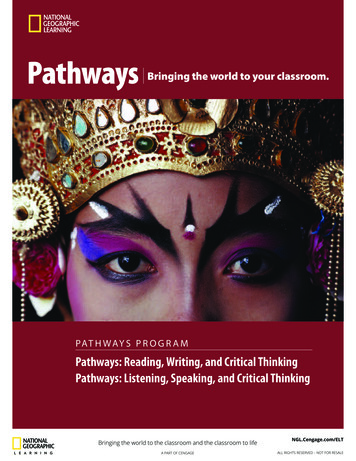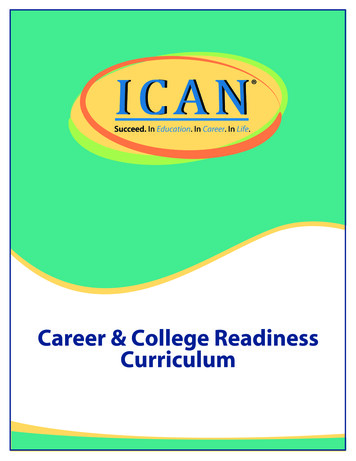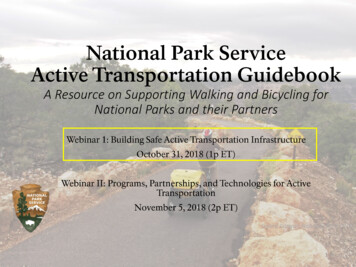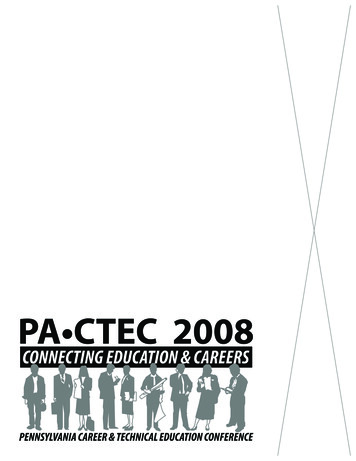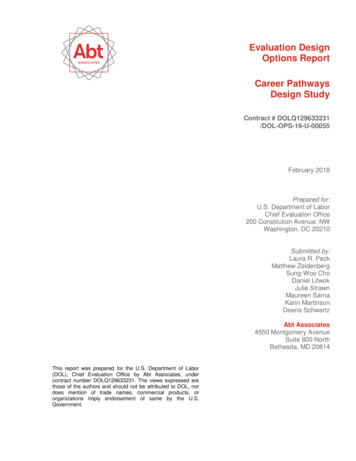
Transcription
Evaluation DesignOptions ReportCareer PathwaysDesign StudyContract # DOLQ129633231/DOL-OPS-16-U-00055February 2018Prepared for:U.S. Department of LaborChief Evaluation Office200 Constitution Avenue, NWWashington, DC 20210Submitted by:Laura R. PeckMatthew ZeidenbergSung-Woo ChoDaniel LitwokJulie StrawnMaureen SarnaKarin MartinsonDeena SchwartzAbt Associates4550 Montgomery AvenueSuite 800 NorthBethesda, MD 20814This report was prepared for the U.S. Department of Labor(DOL), Chief Evaluation Office by Abt Associates, undercontract number DOLQ129633231. The views expressed arethose of the authors and should not be attributed to DOL, nordoes mention of trade names, commercial products, ororganizations imply endorsement of same by the U.S.Government.
ACKNOWLEDGEMENTSAcknowledgementsThe authors of this report are grateful for input from Megan Lizik, Michelle Ennis, and Molly Irwin atthe U.S. Department of Labor; and from the project’s technical working group, which included thefollowing members: Caitlin McLean (Center for the Study of Child Care Employment, University ofCalifornia, Berkeley), Jennifer Craft Morgan (The Gerontology Institute, Georgia State University),Marc Scott (Steinhardt School of Culture, Education and Human Development, New YorkUniversity), Jeff Smith (Professor of Economics, Department of Economics, University ofWisconsin-Madison), Lindsay Page (School of Education, University of Pittsburgh). Bry Pollackprovided editorial assistance.Abt AssociatesCareer Pathways Design Study, Evaluation Design Options Report pg. i
CONTENTSTable of ContentsAcknowledgements.iTable of Contents.iiList of Exhibits.iii1.2.3.4.5.6.About the Career Pathways Design Study . 11.1Findings from the Knowledge Development Phase . 21.2Research Questions and the Organization of This Report. 7Impact on Participant Outcomes . 102.1Introduction to Impact Research Questions. 102.2Research Approaches . 112.3Data Sources. 252.4Practical Considerations and Tradeoffs. 29Workers’ Career Trajectories in the Economy . 323.1Introduction to Career Trajectories Research Questions . 323.2Research Approaches . 333.3Data Sources. 383.4Practical Considerations and Tradeoffs. 42Role of the Public Workforce System . 434.1Introduction to Workforce System Research Question . 434.2Research Approaches . 444.3Data Sources. 454.4Summary . 46Cost Analyses . 475.1Introduction to Cost Research Questions . 475.2Research Approaches . 485.3Data Sources. 535.4Practical Considerations and Tradeoffs. 55Summary and Framework for Considering Research Options . 566.1What to Ask: The Causal or Descriptive Nature of a Research Question . 566.2How to Ask: Approaches to Research Questions and Framework for ConsideringOptions . 576.3Where to Ask: Location Considerations. 606.4Conclusion. 61References . 62Abt AssociatesCareer Pathways Design Study, Evaluation Design Options Report pg. ii
CONTENTSList of ExhibitsExhibit 1. Four Sets of Career Pathways Research Questions (as a Map to This Report) . 8Exhibit 2. Example of 3x3 Factorial Design . 16Exhibit 3. Illustrative Minimum Detectable Effect Size Implications of Alternative EvaluationDesigns. 20Exhibit 4. Example – Sankey Diagram of Occupational Transitions of Nursing, Psychiatric, andHome Health Aides. 35Exhibit 5. Expected Costs of a Career Pathways Intervention, by Perspective. 50Exhibit 6. Cost Analyses in Completed and Ongoing Studies . 55Exhibit 7. Framework for Considering Tradeoffs across Research Approach Options for CausalQuestions . 58Abt AssociatesCareer Pathways Design Study, Evaluation Design Options Report pg. iii
ABOUT THE CAREER PATHWAYS DESIGN STUDY1.About the Career Pathways Design StudyCareer pathways approaches to workforce development offer articulated education and training stepsbetween occupations in an industry sector, combined with support services, to enable individuals toenter and exit training within a pathway at various levels and to advance over time to higher skills,recognized credentials, and better jobs with higher pay. Each step on a career pathway is designedexplicitly to prepare individuals to progress to the next level of employment and/or education. Careerpathways strategies have a sectoral focus, targeting jobs in industries of importance to local andregional economies and striving to build strong relationships with employers. States and localitiesacross the United States have increasingly adopted career pathways approaches.1The career pathways framework evolved over the last decade as a response to emerging evidence onlabor market changes and on the limits of previous employment and training strategies. In the labormarket, individuals with a high school education or less experienced stagnating wages and relativelyhigh unemployment over the last 30 years, whereas those with postsecondary credentials experiencedeconomic gains (Autor, 2015; Carnevale, Jayasundera, & Gulish, 2016). In the workforcedevelopment field, researchers studying long-term outcomes found that the two most commonemployment strategies for low-income adults—quick job placement or stand-alone basic skillsinstruction—neither increased employment and earnings over the long run nor helped participantsescape poverty (Hendra & Hamilton, 2015). By emphasizing postsecondary job skills, careerpathways approaches seek to respond to these labor market changes and to deliver larger and longerlasting impacts than previous employment and training strategies. The career pathways frameworkalso seeks to incorporate promising features of recent workforce development innovations, such astargeting industry sectors and integrating basic education with job training (Werner et al., 2013). Inaddition, the career pathways approach involves providing a range of supports to students includingadvising, financial assistance, and connections to the labor market and jobs.The rapid rise of career pathways strategies, including an emphasis on them in the WorkforceInnovation and Opportunity Act (WIOA), creates a need for more evidence on this approach. To date,research on career pathways programs suggests that they may prove more effective than earliergenerations of employment and training strategies if early positive impacts on attainment ofeducational credentials (both certificates and degrees) ultimately translate into sustained economicbenefits (Elliott & Roder, 2017; Rolston, Copson, & Gardiner, 2017; Martinson, Copson, Gardiner, &Kitrosser, 2018). Although substantial career pathways research is in progress, more research isneeded to enhance the field’s knowledge about career pathways strategies, how best to configurethem, and their long-term effects.WIOA requires the U.S. Department of Labor (DOL) to “conduct a multistate study to develop,implement, and build upon career advancement models and practices for low-wage healthcareproviders or providers of early education and child care” (29 U.S. Code § 3224(b)(4)(I)). In response,the Chief Evaluation Office (CEO) at DOL funded the Career Pathways Design Study and contracted1For a comprehensive history of how the career pathways framework evolved, see The Evolution and Potential ofCareer Pathways (U.S. Department of Education, 2015). For a review of how career pathways program and systemapproaches are currently defined in national frameworks and in practice, see this project’s Career PathwaysImplementation Synthesis report (Sarna & Strawn, 2018).Abt AssociatesCareer Pathways Design Study, Evaluation Design Options Report pg. 1
ABOUT THE CAREER PATHWAYS DESIGN STUDYwith Abt Associates to develop evaluation design options that could address critical gaps inknowledge related to the approach, implementation, and success of career pathways strategiesgenerally, and in early care and education specifically (given the scarcity of information on it relativeto healthcare).This report provides information on potential research approaches to answering key questions aboutcareer pathways strategies that we identified as most relevant to the workforce development field andthat also are less likely to be fully addressed by current ongoing research. It outlines a range of designoptions informed by completed and ongoing studies. These options also reflect the current state ofimplementation of career pathways program- and system-level initiatives, as well as respond toDOL’s interest in improving employment and earnings outcomes for youth and adults.Before detailing these research approaches, this report summarizes what we learned in the first,knowledge development phase of this project about current evidence and implementation in the careerpathways field. It then describes priority research questions that emerged from that work andconcludes by outlining the remainder of the report.1.1Findings from the Knowledge Development PhaseTo understand the current state of the career pathways field and inform the evaluation design optionsto be presented in this report, Abt first undertook a knowledge development effort that producedreports on (1) research and evaluation relevant to career pathways approaches, (2) the implementationof existing career pathways initiatives, and (3) the potential for career pathways approaches in earlycare and education (ECE). This section summarizes the scope, methodologies, and major findingsfrom these reports. Because the approaches used in the first two reports overlap, we summarize themtogether below, and then describe the ECE report separately.1.1.1Career Pathways Research/Evaluation and ImplementationScope and MethodologiesThe first report (Career Pathways Research and Evaluation Synthesis; Schwartz, Strawn, & Sarna,2018) explored relevant research and evaluation. This review focused primarily on the type, scope,and setting of career pathways research that either has been completed or is ongoing; on whatresearch questions have been asked; key findings to date; and areas for further research.We conducted a broad scan of research on career pathways interventions as of February 2017, whichidentified 52 studies, both complete and ongoing. We included studies of interventions that (1) focuson adults (including young adults, but excluding high school students); (2) include occupationaltraining; and (3) describe themselves as involving career pathways, or which include at least somekey element(s) of the pathways approach. 2The research report categorized studies as examining either system-level or program-levelinterventions, or both. System-level interventions address, at least in part, the six career pathwayssystems elements that DOL described in its Career Pathways Toolkit (2015). The six elements are (1)build cross-agency partnerships and clarify roles, (2) identify industry sectors and engage employers,2For example, we included studies of several training efforts that were not explicitly career pathways approaches—insome cases predating the concept—where there were major studies of interventions representing core elements of thecareer pathways model, such as sector training partnerships or integrated basic education and training.Abt AssociatesCareer Pathways Design Study, Evaluation Design Options Report pg. 2
ABOUT THE CAREER PATHWAYS DESIGN STUDY(3) design education and training programs, (4) identify funding needs and sources, (5) align policiesand programs, and (6) measure system change and performance.We categorized interventions as program-level if they included elements of the WIOA definition ofcareer pathways: programs that provide individualized training and supports that (1) align with theskill demands of the state and local economy; (2) prepare individuals to be successful in a range ofsecondary and postsecondary education options; (3) include academic and career counseling, as wellas non-academic supports; (4) provide, as appropriate, concurrent and accelerated program designs;and (5) help individuals to enter or advance within a specific occupation or occupational cluster.Many of the interventions documented in the report included only some of the elements in thesesystem-level and program-level definitions.Whether system or program level, we also noted in our analysis whether or not an interventionprovided more than one step of education or training in a career pathway; or if not, that it at leastclosely linked its training to the specific next training step(s) and actively helped participants enroll inthat next step. We chose to highlight multiple steps of training as a proxy for understanding the extentto which sites in a study focused on career advancement, arguably the most distinctive feature of thecareer pathways framework. By “steps” we mean training opportunities that result in successivelyhigher levels of skills within a career pathway, such as entry-level, mid-level, and advanced training,which correspond to specific, increasingly better-paying jobs.The second report (Career Pathways Implementation Synthesis; Sarna & Strawn, 2018) synthesizedhigh-level information about implementation of 128 career pathways initiatives as of February 2017.Drawing on information from publications and websites, as well as insights from 21 experts withexperience at the local, state, and national levels in career pathways approaches, it described the type,scope, and setting of past and present career pathways initiatives; described how career pathwaysapproaches appear to be defined in practice; summarized experts’ views about the state of the careerpathways field, successes and challenges, and priority research needs; and outlined possible directionsfor future research.Findings in Brief3The Research and Evaluation Synthesis report identified 52 studies of career pathways approachesand related efforts (such as sectoral training). We used the presence of multiple steps of training as aproxy for how “fully developed” a career pathways effort was. Through this lens, about three-quartersof studies (39 of 52) focused on career advancement involving multiple steps of training (and had atleast one site that offered multiple steps of training). That is, they were “fully developed.” In just 12of these 39 studies, all of the sites studied met that definition. This suggests that the research on fullydeveloped career pathways initiatives is fairly limited.In contrast, in the Implementation Synthesis report, which looked at career pathways efforts regardlessof whether they were the subject of research or not, a higher proportion of initiatives (54 of 128, or 42percent) consisted of efforts in which every site included multiple steps of training. This suggests that3For a complete discussion of findings, including matrices with details of each study and implemented initiativereviewed, please consult the full reports: Schwartz et al. (2018) and Sarna & Strawn (2018).Abt AssociatesCareer Pathways Design Study, Evaluation Design Options Report pg. 3
ABOUT THE CAREER PATHWAYS DESIGN STUDYthere may be a greater focus on pathway advancement out in the field than is captured in careerpathways research at this time.We also found that program-level interventions are much more numerous than system-level ones.Among the 52 research studies, 51 of them looked at program-level efforts; and, although 20 lookedat system-level interventions, the research on most of them was in conjunction with program-levelinterventions. However, these numbers may understate the reach of system-level efforts because theytypically have a broader geographic scope (e.g., an entire state or region). Just two studies explicitlyconducted systems-change analyses. Among the career pathways efforts in practice, about one-fifth(23 of 128) of initiatives were solely system-level efforts. This suggests that there may be greaterfocus on implementing system-level career pathways efforts in the field than is reflected in theresearch.Career pathways efforts in the healthcare sector were by far the most commonly implemented (andresearched). Other common sectors included manufacturing, information technology, and business(e.g., accounting, office/clerical occupations). Career pathways programs most commonly targetedlow-income individuals; typical participants were high school graduates in their late 20s or 30s andmore likely to be female than male. 4 Few studies included substantial percentages of people ofHispanic descent or youth, and few included significant percentages of individuals with employmentbarriers such as no high school diploma, very low skills (less than eighth grade), limited Englishproficiency, criminal records, or disabilities.The studies asked a diverse set of research questions, most commonly focused on what theintervention was, how it was implemented, and whether it was effective. Thirty-eight of the 42 studiesfor which we identified outcomes included at least one employment outcome (most frequentlyearnings, employment, and hourly wage); 29 included at least one education outcome (mostfrequently the receipt of a certificate or degree). Only about one-third of the studies in our reviewincluded research questions that either specifically mentioned career pathways in a question orincluded questions about an intervention that was explicitly described as a career pathways approach.Among the studies we identified, findings have been published for four quasi-experimental and eightexperimental evaluations—using methods that allow researchers to attribute outcomes to theprogram—that measured the impact of the program on participants’ outcomes. 5 (This is in contrast tonon-experimental, descriptive studies, which document program implementation or measure anddescribe participants’ outcomes, but do not use a comparison or control group to approximate whatwould have happened in the absence of the program and therefore determine whether the programcaused a change in outcomes.) Highlights of the findings include the following:4Career pathways participants may be more likely to be female because many studies were of the healthcare sector,which tends to employ more women than men.5In brief, an experimental evaluation involves randomly assigning eligible units (be they people, organizations, orgeographic locations, for example) to gain access to one condition (a policy, program, or intervention) or to be deniedsuch access (control). Any differences between outcomes for the two groups are attributable to the intervention understudy. A quasi-experimental design uses methods other than random assignment to estimate a counterfactual condition(or what would have happened in the absence of the intervention), from which to estimate impacts.Abt AssociatesCareer Pathways Design Study, Evaluation Design Options Report pg. 4
ABOUT THE CAREER PATHWAYS DESIGN STUDY Ten of these published impact findings are for short-term (one to two years) and medium-term(three to four years) follow-up periods. Two studies to date have reported impact findings forlong-term outcomes (five years or longer). This represents a significant evidence gap becauseanalyses comparing short-term and long-term impacts for education and training programs findthat results can change substantially over time, with economic impacts for skill developmentoften small initially but growing larger with longer-term follow-up (Card, Kluve, & Weber, 2010;King, 2004). In addition, short- and medium-term follow-up likely will fail to capture the extentto which participants advance or not through more than one step of career pathways trainingand/or employment over time—a central question for the career pathways model. Nine of these impact studies examined earnings. Three found statistically significant positiveresults, five found mixed results, and one found mostly negative results. 6 Ten of the studies examined educational outcomes. Seven found statistically significant positiveresults, one found mixed results, and two found mostly negative results. Of the eight random assignment studies reporting impacts, only one included at least one site thatoffered multiple steps of training. Across all of the studies we examined, researchers found that implementing a model as intendedoften proved challenging. In addition, programs varied considerably in the populations targetedand served, and in targeted sectors and occupations.Looking forward, more than half of the research studies on career pathways initiatives are ongoingstudies, and more than half of all the implemented career pathways initiatives we examined are stillactive. Ten of the studies will report impact results by 2018 and 26 of them will report results by2021; 76 initiatives currently operate in the field. This means that in the next five years, considerablymore will be known about career pathways strategies both from research and from practice.As described below, these future career pathways reports will fill some specific gaps in the existingevidence, and will do so using more rigorous research than many of the previous studies. More thantwice as many ongoing studies use random assignment and quasi-experimental methods (24) as didcompleted studies (11). Important questions that will be addressed by future research include these: Research explicitly focused on the career pathways model. Of the studies that included researchquestions explicitly focused on career pathways, 61 percent are ongoing. This includes five of thesix experimental studies with explicit career pathways questions, and two studies aimed atunderstanding how career pathway programs and efforts can and do use metrics to understandthose pathways in practice.76What we call “mixed results” include two or more of the following: statistically significant positive results, statisticallysignificant negative results, or non-statistically significant positive or negative results.7The Alliance for Quality Career Pathways is working with state career pathways efforts to determine the predictivepower of interim metrics. The Career Pathways Programming for Lower-Skilled Adults and Immigrant study is adescriptive study addressing what short- and long-term outcome measures adult education providers commonly use andreport for career pathways participants.Abt AssociatesCareer Pathways Design Study, Evaluation Design Options Report pg. 5
ABOUT THE CAREER PATHWAYS DESIGN STUDY Research on career pathways approaches offering more than one step of training. More ongoingstudies (22) include at least one site with multiple steps of career pathways training than didcompleted studies (17). While the most common occupational training provided in these studies isfor entry-level positions, our Research and Evaluation Synthesis report suggests many sitesincluded in ongoing studies also offer preparation for mid-level jobs. Long-term outcome and impact findings. A number of the ongoing studies are followingparticipants for five years or more and will be able to report on long-term outcomes and impactson employment and earnings. More analysis of program costs. Ten of the ongoing studies are examining program costs but onlyfour were completed studies. Some of these also are examining questions of programsustainability. Exploration of the effectiveness of specific components within a career pathways approach. Threeof the ongoing studies have research questions about the impact of specific program components,such as the Health Profession Opportunity Grants (HPOG) Impact Study’s test of facilitated peersupport, emergency assistance, and non-cash incentives within a career pathways model. More analysis of systems change initiatives. Among the 20 studies that analyze career pathwayssystem change initiatives, 13 are ongoing as compared with just seven completed. 81.1.2Career Pathways Initiatives in Early Care and EducationScope and MethodologyThe third report (Career Pathways in Early Care and Education; Cheng et al., 2018) examines thepotential for career pathways approaches in the ECE sector, which includes child care, preschool, andprekindergarten services. Consistent with the WIOA legislative mandate for this project, it focuses onlow-wage workers in jobs providing direct care and teaching in the ECE field. For the analysis in thisreport, we reviewed current research about the ECE workforce released by federal agencies andprominent organizations engaged in ECE research, and we held group discussions with 23 expertsfrom federal and state agencies, Head Start and prekindergarten systems and programs, communitycolleges, leaders of national ECE organizations, and researchers on ECE.Findings in BriefThe Early Care and Education report identified few initiatives aimed at creating ECE careerpathways strategies as of February 2017. Among research studies on career pathways initiatives andamong implemented career pathways efforts, about 10 percent included ECE occupations. The maincareer pathways program models that exist in this sector are Registered Apprenticeship and theTeacher Education and Compensation Helps (T.E.A.C.H.) Early Childhood Initiative.Rather than comprehensive career pathway approaches, the report found promising practices aimed ataddressing various barriers specific to ECE worker advancement, such as wage and compensationsupplements, and efforts to provide portable credentials and articulation and credit for prior learning.8These studies are addressing questions about how various institutional types implement career pathways approaches,the sustainability of career pathways approaches, and how different types of partners contribute to career pathwaysapproaches.Abt AssociatesCareer Pathways Design Study, Evaluation Design Options Report pg. 6
ABOUT THE CAREER PATHWAYS DESIGN STUDYThese practices hold the possibility for becoming the building blocks of comprehensive careerpathways in the ECE field, but given pervasive low wages in the field (outside of public schoolemployment) it is unclear whether the structure of employment and compensation in the ECE fieldoffers enough advancement opportunities to make career pathways strategies viable.1.2Research Questions and the Organization of This ReportThe three reports detailed above each culminated in the description of a number of research questionsthat, if answered, would advance our understanding of career pathways system- and program-levelstrategies. We narrowed the questions in collaboration with DOL to a list of research questions thatreflect those most relevant to the workforce development field and that also are l
Exhibit 4. Example - Sankey Diagram of Occupational Transitions of Nursing, Psychiatric, and Home Health Aides 35 Exhibit 5. Expected Costs of a Career Pathways Intervention, by Perspective 50 . with Abt Associates to develop evaluation design options that could address critical gaps in knowledge related to the approach, implementation, and .
